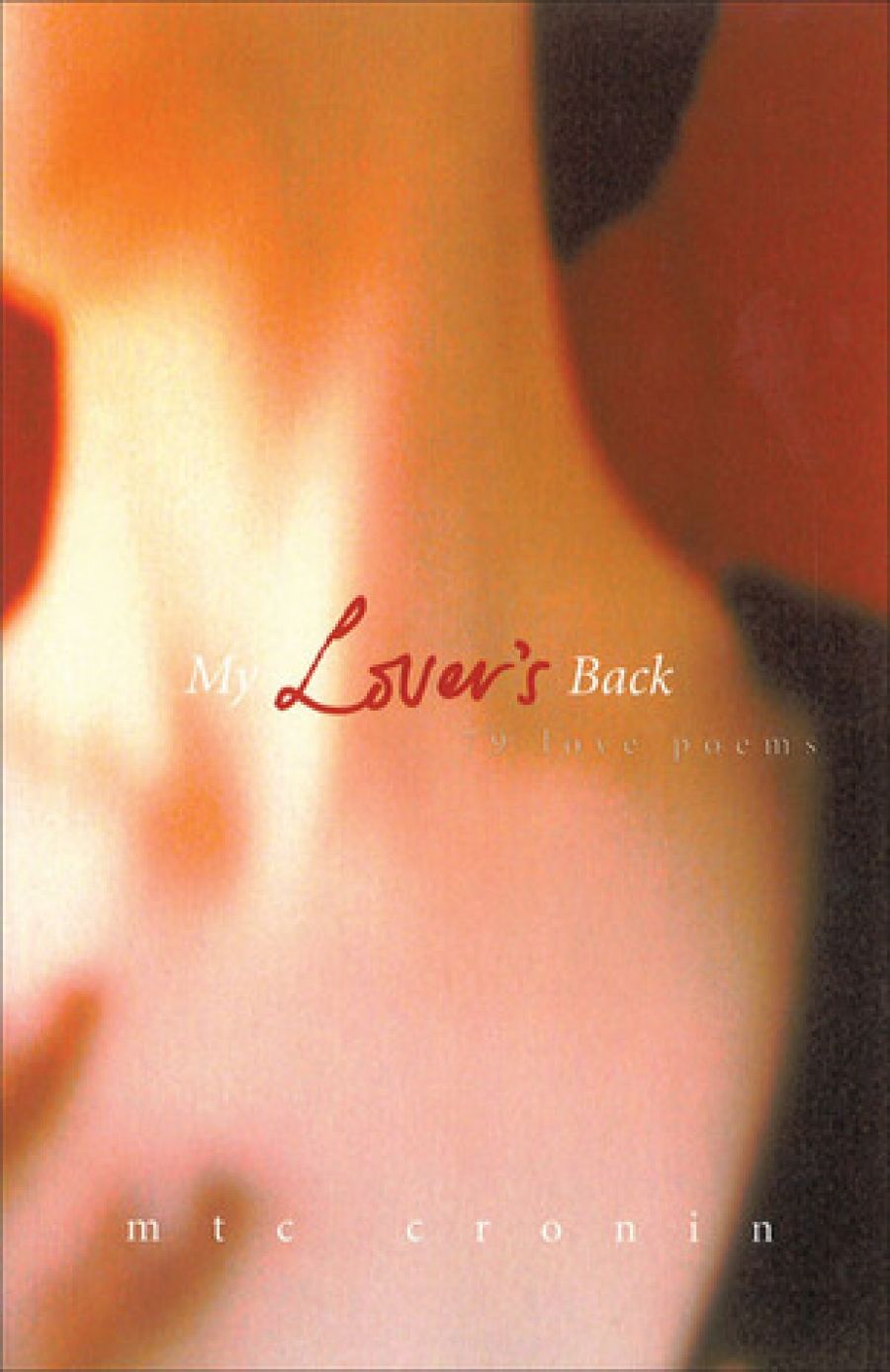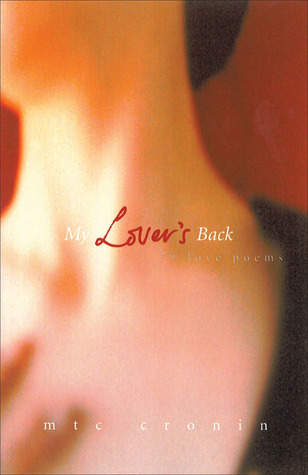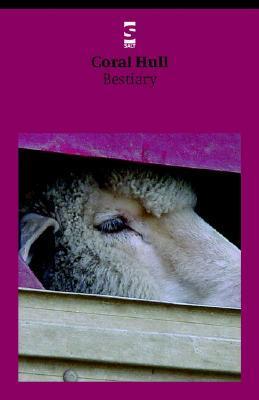
- Free Article: No
- Contents Category: Poetry
- Review Article: Yes
- Article Title: Inwardness and Outwardness
- Online Only: No
- Custom Highlight Text:
Who hasn’t written a love poem? ... Our letters are love poems. Our TV soaps, our films and our songs are love poems ...[Cronin’s] collection is for anyone who has loved, who loves or who wants to be in love, here and now.
- Book 1 Title: My Lover's Back
- Book 1 Subtitle: 79 Love Poems
- Book 1 Biblio: UQP, $19.95 pb, 121pp
- Book 1 Cover Small (400 x 600):

- Book 1 Cover (800 x 1200):

- Book 2 Title: Bestiary
- Book 2 Biblio: Salt, $19.95 pb, 101pp
- Book 2 Cover Small (400 x 600):

- Book 2 Cover (800 x 1200):

Cronin’s poems are small, and deliberately so. This smallness is a part of their achievement: a precise and highly polished inwardness. Typically, they are set in the lovers’ bedroom (which, in its enclosure and privacy, also serves as an emblem of the kind of love Cronin imagines in this collection), and their images rarely reach out to the actual. They are images of the moon, thorns and petals, dreams and awakenings, heat and ice; images that derive from Petrarch and early Renaissance traditions of love poetry. As such, they don’t create a sense of the world outside but, rather, an enclosed idiom of love.
Formally, too, Cronin’s poems are finely worked. They frequently use the short lines and long pauses – the reduced style – of haiku. ‘Lovers’, the first poem in this collection, starts: ‘Lovers / should think about / being lovers.’ Almost all the poems that follow think about love or being a lover in similarly small phrases; phrases issued, as it were, from the largeness of the pause, so that we almost always feel the controlled effort it takes to say ‘whatever can be said / and all that can’t’.
This phrase, from Cronin’s poem ‘Face’, reaches back to Sir Philip Sidney’s acute question in his sonnet sequence, Astrophil and Stella: ‘What may words say, or what may words not say’ (Sonnet 35). Cronin’s highly polished, slightly riddling style owes more, I think, to a Renaissance sonnet’s tendency towards extreme self-reflection than to any postmodern scepticism about language. If Cronin plays upon the distance between words and things, she makes that distance serve as an image of the solipsism in desire or the distance in love. ‘Precious Letters’ begins: ‘the distance: the gift // lovers / embracing // words / embraced / by emptiness // the space / needed by love.’
‘Distance ... emptiness ... space’; in this collection, love and poetry rarely take their place in a world of facts and other people. Instead, they are surrounded by this ‘space needed by love’ that Cronin sometimes imagines as desire and sometimes as oblivion:
The real world is disappearing
And the trees have become faint
Would soon be sky
If the sky was there at all
The cats have licked themselves up
Like places of cream
And silently repeating itself
The last bird’s cry
Flew off to nowhere ...
This is a poem where the receding world is only a supposition (‘If the sky was there at all’). Such a fine art of space and surfaces gives the passion that is the subject of these poems a quality of isolation, and self-enclosure. This makes the progress of this collection, which is one of disintegration (from a section called ‘Lovers’ to ‘Survivors’ to ‘Liberty and Pain’), seem inevitable.
Perhaps the finest example of Cronin’s controlled and imaginative sense of ‘nowhere’ is her poem ‘Distance’:
If I am to be what is measured and found to be
a world away from you
then my closed eyes shall traverse that distance
and carry within their dark journey
the knowledge that only individuals love.
And in my struggle with loneliness which bears
no smell but the smell of you
and the shape of you my imagination would
sculpt if its hands fell into clay
I will arrive still and silent and fully in your heart ...
This poem, starting with an ‘If’, proceeds through negations and hypotheticals. Its slow, almost liturgical, rhythms make a ritual of closed eyes and loneliness, and give dimension to its entirely inward world of love, which is ‘nowhere’.
Coral Hull’s poetry, on the other hand, is distinctive for the directness – the sheer conviction – of its engagement with the outside world. Hull is always looking at things most of us prefer not to see: ‘The RSPCA Horse’; ‘The Dog’s Grave’; and ‘Feedlot Cattle in the Rain’. In her best poems, the polemic is in the detail, in her attention to the terrible and precise fact of suffering:
on the road from darwin to katherine a dirty white
ball of pelican / its yellow rimmed black eye &
confusion of feathers burning dry / the grey road …
In giving this detail, her lines overrun their rhymes and rhythms (sometimes marked mid-line with an oblique), and this effect of impatient comprehensiveness is matched by sudden imaginative amplitudes. Her poems take as their scope a vast and impersonal landscape:
at the end of the world there
will be pelicans / flocked & centred their huge
wings flapping out that mysterious wind which
howls down deserts
This quick movement in her poetry from small details to large imaginings is what gives force to her startling image, ‘yet entire continents are in the eyes of cockatoos’ (‘Cockies’).
In an interview, Hull stated: ‘I appropriate from other sources – to give the object of my interest some external truth beyond my perceptions and to teach myself to look beyond my own emotional response or what is inside me.’ It is this sense of the real that gives her poetry its power to engage, and to shock. For instance, in this collection she records her father’s stories of the land, and his laconic narrative gives them a peculiar plangency.
This poem is part of the ‘Darling River Back Block Sequence’, perhaps the strongest in this collection. Its twelve poems record the life and slow death of the river with Hull’s characteristic combination of storytelling, sharply imagined detail and stark fact.
With characteristic urbanity, in his work On the Art of Poetry, Horace defined two purposes for poetry: to delight and to instruct. We might understand the difference between these two collections in those terms. Essentially, Cronin writes to delight; she declares: ‘I write poetry because, for me, it is a way of “being” in the world.’ Hull, on the other hand, writes to instruct, or even convert. With a combination of rage and precision – with a precision that is in itself a kind of rage – she records the damage we do to animals and the land.
It may prove more useful to understand the difference between these two collections as the difference between what we might call a poetry of inwardness and a poetry of outwardness, insofar as these (overly large) terms take their meaning from Hull’s statement: ‘Once I was the most interesting and confusing thing to myself, but now the things of the land fill me.’ Hull’s collection looks out at ‘the things of the land’, whereas Cronin’s collection looks inward; it treats the self as ‘the most interesting and confusing thing’.


Comments powered by CComment